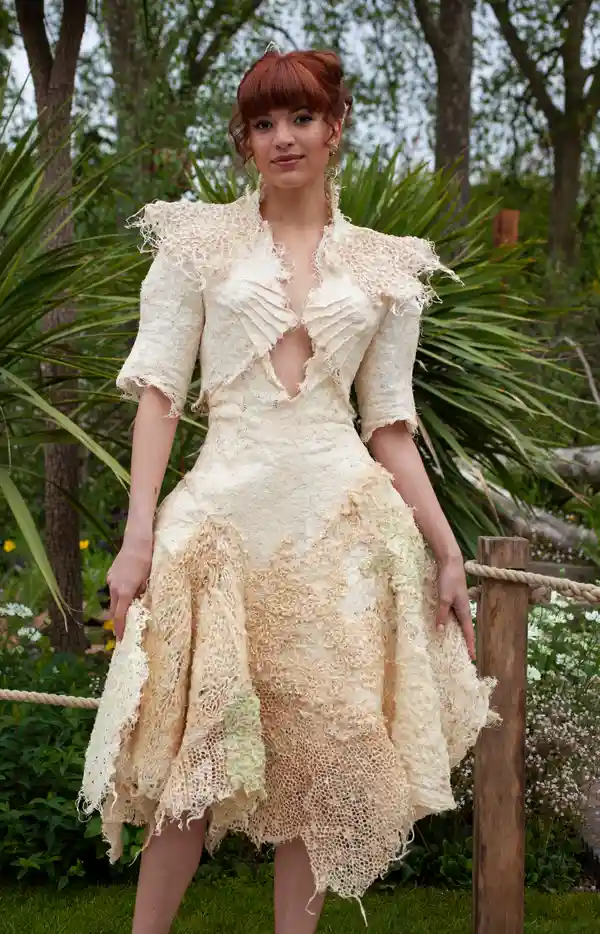
Innovative Biodegradable Wedding Dresses Made from Wheatgrass Roots
Wedding dresses are typically worn once and then stored away, leaving many brides with a sense of regret. However, a solution to this problem may have been found at the Chelsea Flower Show, where one grower has showcased biodegradable wedding dresses made from the roots of wheatgrass.
These stunning dresses are the work of designer Zena Holloway, who was inspired to create a sustainable material after years of working as an ocean photographer and witnessing the devastating effects of plastic pollution on marine life.
Holloway explained, “I saw the growing amount of plastic in the ocean over the years and became upset about the materials we were using.” This led her to experiment with different materials until she discovered that the roots of wheatgrass could be woven into a sustainable, biodegradable fabric.
The result is a series of beautiful wedding dresses that are not only stunning but also environmentally friendly. These dresses offer a solution to the problem of single-use wedding dresses that are often discarded and left to languish in wardrobes and landfills.
By using wheatgrass roots to create her dresses, Holloway has not only created a sustainable alternative to traditional wedding dress materials, but she has also shown that eco-friendly fashion can be beautiful and innovative. Her designs are a testament to the power of creativity and innovation in solving environmental challenges.
Overall, these biodegradable wedding dresses made from wheatgrass roots are a shining example of how fashion can be both beautifuland sustainable. They represent a step forward in the fashion industry’s efforts to reduce waste and carbon emissions, and offer a glimpse into a more environmentally conscious future. With more designers and innovators like Zena Holloway, we can hope to see more sustainable fashion solutions that are both stylish and eco-friendly.

Designer Creates Sustainable Wedding Dresses Using Wheatgrass Roots
Designer Zena Holloway has created sustainable wedding dresses using wheatgrass roots, with the aim of reducing the fashion industry’s environmental impact. Her fascination with the root-like structure of fungi, known as mycelium, led her to experiment with different materials until she discovered the potential of wheatgrass roots to create a sustainable, biodegradable fabric.
Holloway grows wheatgrass over different materials, such as corals and beeswax, allowing it to adopt the shape of natural molds. Once enough roots have grown, she treats the material with beeswax to give it natural strength. The resulting material is a pale, twisting fabric that looks ethereal and is similar in appearance to bleached coral.
Holloway’s sustainable wedding dresses offer a solution to the problem of single-use wedding dresses. The dresses can be sustainably disposed of by returning them to nature, for example, by wearing them to an ocean wedding and allowing them to be eaten by fish.
Holloway hopes her work inspires others to use sustainable, biodegradable materials in the fashion industry. The industry is responsible for between 2% and 8% of global greenhouse gas emissions, and its environmental footprint is expected to grow by 60% by 2030, according to the World Resources Institute.
The Royal Horticultural Society’s Chelsea Flower Show, where Holloway showcased her dresses, is putting a focus on sustainable growing. Gardeners are being tasked with demonstrating howtheir work is eco-friendly, and every garden must now have a relocation plan after the show, rather than being disposed of. The show also has a competition for sustainable gardening products, won this year by Lindum Wildflower Turf, which is grown without plastic matting and supports a range of pollinators and insects with its 27 species of wildflowers, perennials, and herbs, native to the UK.
This year’s focus is also on resilient plants, with the Chelsea Flower Show plant of the year awarded to the deep purple agapanthus black jack, which is heat and drought tolerant and favored by pollinators. These initiatives demonstrate a growing awareness of the importance of sustainability in the fashion and gardening industries and the need for innovative solutions to reduce environmental impact.